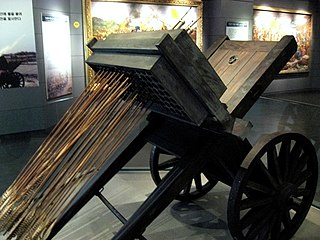The Battle of Sacheon was a naval engagement on May 29, 1592 during the Imjin War (1592–98). It occurred at Sacheon where Yi Sunsin's fleet managed to destroy 13 large Japanese ships. It was the first battle of Admiral Yi's 2nd Campaign in the Imjin War, between Japan and Korea, when the turtle ship was first used.
The naval Battle of Chilcheollyang took place on the night of 28 August 1597. It resulted in the destruction of nearly the entire Korean fleet.

The Hamgyong campaign, also known as Katō Kiyomasa's northern campaign, was Katō Kiyomasa's invasion of the northeastern Korean province of Hamgyeong during the Japanese invasions of Korea (1592–1598). The campaign was largely due to the help of Korean defectors who also handed over to the Japanese their princes Sunhwa and Imhae. The Japanese reached the northeastern edge of Hamgyeong, crossed the Duman River, and attacked the Orangai Jurchens, but met with heavy resistance. Katō returned south and took up residence in Anbyeon while Nabeshima Naoshige headquartered in Gilju. By winter local resistance began pushing back at Japanese occupation and laid siege to Gilju.

The siege of Busanjin was a battle fought at Busan on 24 May 1592, between Japanese and Korean forces. The attacks on Busan and the neighboring fort of Dadaejin were the first battles of the Japanese invasions of Korea (1592–98).
The siege of Namwon was a military engagement that occurred from 23 September to 26 September 1597. It ended in Japanese victory.

The Battle of Hansan Island and following engagement at Angolpo took place on 8 July 1592. In two naval encounters, Korean Admiral Yi Sun-sin's fleet managed to destroy roughly 100 Japanese ships and halted Japanese naval operations along the southern coast.
The siege of Pyongyang was part of the Japanese invasions of Korea. Konishi Yukinaga, a Japanese daimyō, captured Pyongyang and garrisoned his force in the winter of 1592.

The siege of Pyongyang was a military conflict fought between the allied Ming-Joseon army and the Japanese First Division under Konishi Yukinaga. The battle ended in victory for the allies but a successful retreat from Pyeongyang by the remaining Japanese in the night of 8 February 1593.

The Battle of Haengju took place on 14 March 1593 during the 1592–1598 Japanese invasion of Korea. The Japanese attack failed to overcome Haengju fortress.
The Battle of Danghangpo was a naval engagement during the Japanese invasions of Korea (1592–98) that resulted in Korean victory.
The Battle of Dangpo was a naval engagement during the Japanese invasions of Korea (1592–1598) on 10 July that resulted in Yi Sun-sin's victory.
The Battle of Sacheon (泗川) was a siege by Korean and Chinese forces against the Japanese fortification of Sacheon from 6 to 11 November 1598. It ended in Japanese victory.

The siege of Ulsan was an unsuccessful Ming-Joseon attempt to capture Ulsan from the Japanese. The siege lasted from 26 January to 19 February 1598.
The Battle of Dadaejin and the Siege of Busan were the first battles of the Japanese invasions of Korea (1592–1598) and occurred simultaneously on April 13–14, 1592.
The Battle of Cheongju was a battle during the Japanese invasions of Korea (1592–98). Jo Heon attacked the Japanese-held city of Cheongju and captured it on 6 September 1592.
The Battle of Byeokjegwan was a military engagement fought on 27 February 1593, between the armies of the Ming dynasty led by Li Rusong and Japanese forces under Kobayakawa Takakage. It resulted in a Japanese victory and Ming retreat.
The Battle of Jiksan was a military conflict fought between Ming and Japanese forces on 16 October 1597. It resulted in withdrawal by both sides. However the battle marked the furthest point the Japanese ever got to reaching Hanseong during the Second Invasion.

The siege of Suncheon was an unsuccessful Korean and Chinese Allied Forces attempt to capture Suncheon Japanese Castle late in the Japanese invasions of Korea (1592–1598).
The Battle of Pyongyang (1592) was a military engagement during the Japanese invasions of Korea (1592–1598). On 23 August 1592 a Ming force of 6,000 under Zu Chengxun and Shi Ru attacked Japanese-occupied Pyeongyang and was defeated.






